How Do I Start Coloring? (Part 1) A list of supplies to begin your coloring journey!
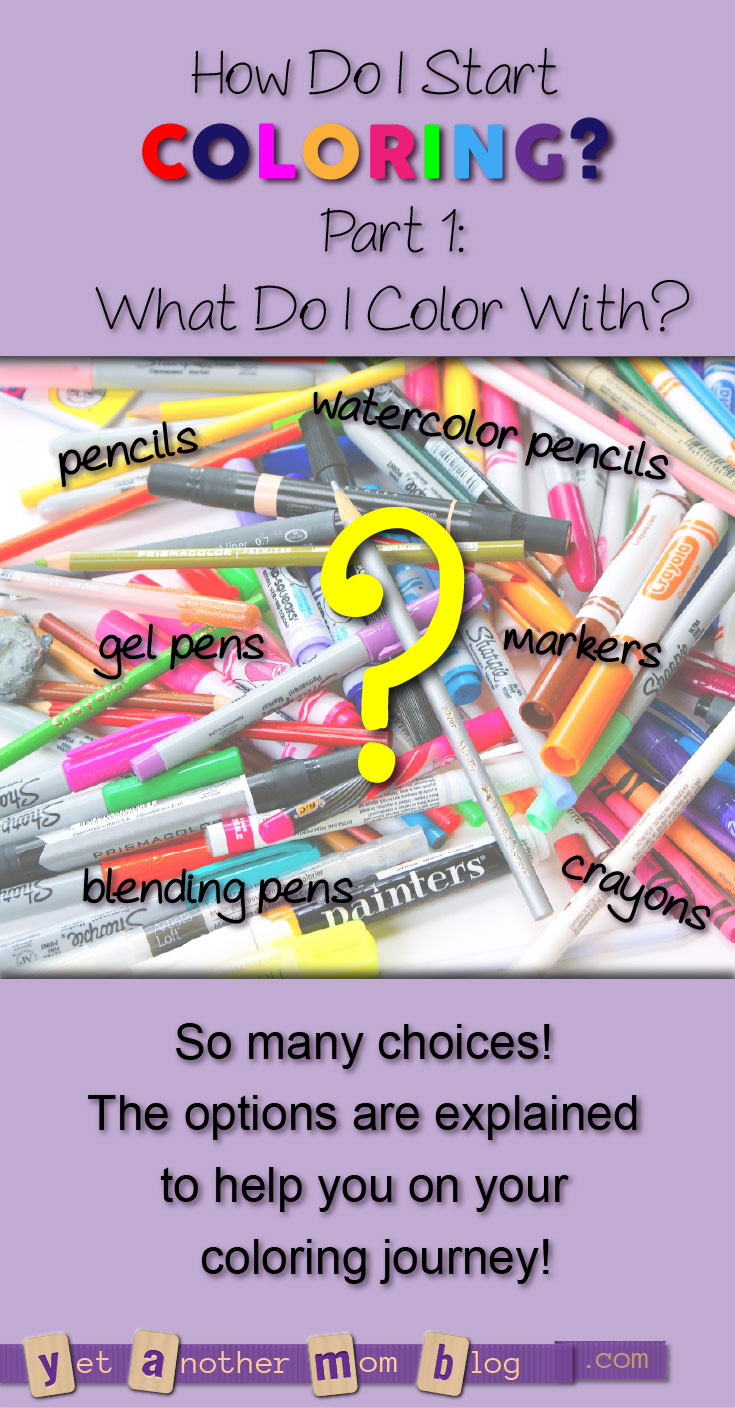
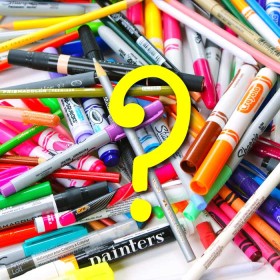
Did you just learn about the new adult coloring movement? If you want to join in the fun but don’t know where to start, read on and I’ll help you navigate the world of coloring!
Note: this post may contain affiliate links to products I use and/or would recommend. This post is not sponsored, nor have I received any other form of compensation from these companies. All opinions are my own. I have included links so that you can easily find the products I am referring to, and, if you decide to purchase something through one of these links, I receive a small compensation for sending you to them, but it does not cost you a penny more. I use these meager earnings to help support my blog. You can read my full disclosure here.
I belong to several Facebook coloring groups, and the first questions almost all newbies ask when they join the group are: What do I color with? What do you recommend? Is this brand better than that brand? How do you do a shading effect? Where can I get coloring books or coloring pages to color?
While I haven’t been an active colorer all my life, I have used many different types of media (i.e., what you color with), of all different brands and qualities over many, many years, plus I have been reading the responses I see to these questions across all of the groups recently and I have compiled a short primer here to help you sort through the overwhelming number of products to get you started!
I will cover the topic of what to color in Part 2.
This is a fairly long post, but I really didn’t want to leave anything out, because I know you want to learn as much as you can about your new (or soon-to-be) obsession! In each section, I have listed my “quick pick recommendations” for recommended products in that category. I will explain more about these recommendations (and products to avoid) later, since I’ve run out of time and space here.
Types of Media
The first consideration is what to color with. There are crayons, colored pencils, water-based markers, alcohol-based markers (a.k.a. permanent markers), gel pens, watercolor pencils, pastels, watercolor paint, paint pens,… the list goes on. What is the difference? Which should you use? This, my friend, is really a personal preference. Read the pros and cons below and see what you prefer.
Crayons
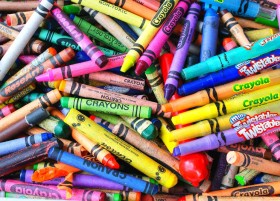 Everyone has colored with crayons as a kid. While popular for children, they aren’t as popular with adults, as they are difficult to use on fine details and the color can be blotchy.
Everyone has colored with crayons as a kid. While popular for children, they aren’t as popular with adults, as they are difficult to use on fine details and the color can be blotchy.
However, crayons are easy to find and cheap (especially during back-to-school sales) and can still be fun to use with the right design.
Quick Pick Recommendation(s) for Crayons:
- Crayola Ultimate 152-Count Crayon Collection with Case and Sharpener
- Crayola 24-Count Twistables Crayons (if you haven’t seen these, check them out! I love them!)
- Crayola 8-Count Extreme Colors Twistables Crayons (ultra-bright colors)
Colored Pencils
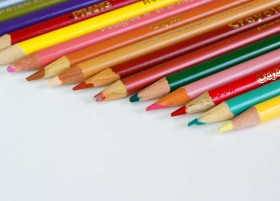 Colored pencils are versatile for fine detail or large areas and are probably the most used media for coloring by adults. It is much easier to blend and shade with them than markers. You can apply lightly for faint color or build up layers for more saturated color. And you can even layer two colors to achieve another color (e.g., blue and green to get turquoise), so you don’t have to have a huge set to get a wide range of colors. If you are using lightly applied layers of color and make a mistake, you can usually erase your mistake. And they work well on almost all types of paper.
Colored pencils are versatile for fine detail or large areas and are probably the most used media for coloring by adults. It is much easier to blend and shade with them than markers. You can apply lightly for faint color or build up layers for more saturated color. And you can even layer two colors to achieve another color (e.g., blue and green to get turquoise), so you don’t have to have a huge set to get a wide range of colors. If you are using lightly applied layers of color and make a mistake, you can usually erase your mistake. And they work well on almost all types of paper.
What are the drawbacks to colored pencils? They usually aren’t as vibrant as markers. And, unless you use a blending medium (see more below), you will get a slightly textured look to the coloring as opposed to a solid, saturated look (this isn’t really a drawback, just a difference). Some people find that their hand cramps up using pencil, but it is often a result of their technique and the quality of their pencils. If the pencil lead is hard or the pigment of inferior quality, you’ll have a tendency to push harder to try to get the color more saturated on the paper. Even with quality pencils, you should apply many light layers and build up the color instead of applying lots of pressure to try to get maximum coverage on the first layer.
There are many different kinds and grades of pencils out there which can be overwhelming to a newbie. Pencils can be made with wax or oil or other fillers, which affects how hard or soft the pencil is, which then affects how smoothly and quickly the color is applied to the page. Pencils also have different quality pigments, which affect the richness of the color. I’ve divided the recommendations below into three categories. The beginner sets I’ve listed are truly the best for the price. Many of the other cheap sets you’ll find have poor pigment quality and are very hard, so you will not get smooth, rich colors. The student-grade sets are those recommended for art students, so they are a step up from pencils for children, but still more economical than the highest, artist-grade sets. If you think you’ll be in this for the long haul, the artist-grade sets are truly your best bet with the best pigments, smoothness, blendability, and color selection. But if you aren’t sure, buy a beginner or student set and then buy some individual colors of the artist grade pencils (you can usually find them sold individually at craft or art stores).
Note that you can get metallic pencils which can be used for some nice effects. While not as shiny and shimmery as the metallic or glitter gel pens, they can still be a lot of fun to add sparkle to some fairy wings or shimmer on a leaf.
Quick Pick Recommendations for Colored Pencils – Beginner sets (why?):
- Crayola 50-Count Long Colored Pencils
- Faber-Castell 24-Count Triangular Colored EcoPencils
- Crayola 30-Count Twistables Colored Pencils (plastic barrel, doesn’t need sharpening!)
Quick Pick Recommendations for Colored Pencils – Student-grade sets (explain):
- Prismacolor Scholar 48-Count Colored Pencils
- Faber-Castell 36-Count Classic Color Pencils Tin
- Sanford (aka Prismacolor) Col-Erase 24-Count Erasable Colored Pencils
Quick Pick Recommendations for Colored Pencils – Artist-grade sets (explain):
- Prismacolor Premier 72-Count Soft Core Colored Pencils (also comes in 48-count and 132-count)
- Derwent Coloursoft 72-Count Pencils (almost as soft as a pastel)
- Faber-Castell Polychromos 36-Count Colored Pencils Set (oil-based, bigger sets available)
- Koh-I-Noor Progresso Woodless Colored Pencils, 24-Piece Set (economical artist-grade)
Quick Pick Recommendations for Specialty Colored Pencils:
- Faber-Castell 12-Count Metallic Colored EcoPencils (it’s fun to add some shimmer!)
- Derwent Colorsoft Skintone Pencils, 6 Count
Markers
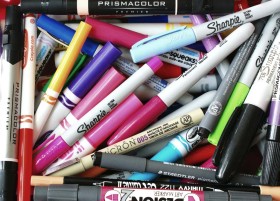 Markers are the second most popular coloring media for grown ups. When it comes to markers, there are a basically two types to consider:
Markers are the second most popular coloring media for grown ups. When it comes to markers, there are a basically two types to consider:
Water-soluble markers are usually non-toxic and washable. They do not have permanent ink (which is a pro or con, depending if you are doing a piece of art to keep on display or just for fun). Water-based markers do not saturate the page as much as alcohol or solvent based markers, and, while this is a plus that they don’t typically bleed through the paper much if at all, it means that they don’t color as smoothly and you’ll often see banding of color where your strokes overlap or overall blotchiness. They can be difficult to blend or shade with (without the help of a blending marker). But they are cheap and accessible, and great for kids or adults for beginning coloring on designs with small detail. There are some higher-end water-soluble markers, often used by stampers and scrapbookers, that perform much more like an alcohol-based marker.
[CONSIDER ADDING:http://amzn.to/1DhIwAE Staedtler Textsurfer Classic Highlighter, Chisel Tip, Blue/Green/Orange/Pink/Purple/Red/Turquoise/Yellow, 8 per Set http://amzn.to/1OeApLC Staedtler Triplus Textsurfer Highlighter, 4 Color Set http://amzn.to/1fKaJeq Eco Highlighter Pencils – Set of 5 Colors – Will Not Bleed or Dry Out – Includes Wooden Sharpener http://amzn.to/1fKaX5t Staedtler Textsurfer Dry Highlighter Pencil 128 64 Drawing for Writing Sketching Inkjet,paper,copy,fax(pack of 4) (Color Mix-4 Pencils)
]
Quick Pick Recommendations for Water-Soluble Markers:
- Crayola 50-Count Telescoping Pip-Squeaks Marker Tower (cheap beginner set, in a great storage case!)
- Staedtler Triplus 20-Count Fineliner Pens (for small areas)
- Tombow 96-Count Dual Brush Pen Set (artist-grade; smaller sets available, favorite of stampers!)
Alcohol markers or solvent-based markers provide excellent, smooth coverage and vibrant colors, which make them a favorite for coloring. They have permanent dye-based ink, and many are archival quality. They can be blended (with the right tools—see below for more details), although not as easily as with colored pencils. One problem people have with some of these is the odor. Some, like Sharpies, can have pretty noticeable fumes. But not all are that bad, and not all people are bothered by it. Another negative is the bleeding of color. Most of these markers will bleed through to the back of the paper. So if you have a coloring books with designs on both sides of the page, you will not want to use markers on it. The bleeding also happens on the right side when coloring. There is a learning curve to find how close to an edge line you should get. Some markers bleed quite far out from the tip of the marker, so it’s a bit of trial and error.
Quick Pick Recommendations for Alcohol-Based Markers – Beginner-grade sets:
- Sharpie 24-Count Fine Point Permanent Markers (and Ultra-Fine Points)
- Sharpie 6-Pack Metallic Fine Point Permanent Markers (to add some bling!)
- BIC Mark-It 36-Count Fine Permanent Markers (and Ultra Fine Tips)
- BIC Mark-It 16 Count Metallic Color Collection (add some sparkle!)
Quick Pick Recommendations for Alcohol-Based Markers – Artist-grade sets:
- Prismacolor Premier 48-Count Double-Ended Art Markers (brush tip/fine nib) (also comes in 24-count and 72-count) (chisel tip also available).
- Prismacolor Premier 12-Pack Double-Ended Art Markers, Cool Gray (10%-90% range; other sets available: Warm Gray, French Gray)
- Copic Markers 36-Piece Basic Set (more expensive, but refillable & replaceable nibs saves you money in the long run)
- Copic Markers 6-Piece Sketch Set, Skin Tones (excellent skin-tone collection!)
- Spectrum Noir 72-Piece Pen Set (double-ended, refillable, replaceable nibs)
- Sakura 6-Piece Pigma Micron Ink Pen Set, Black (for drawing/redefining outlines)
- Chameleon 22 Pen Deluxe Set (unique system gives you multiple tones from one pen for the ultimate gradients, but there is a learning curve)
If you make a mistake with either type of markers, correcting it is a problem. If it’s on an outside edge, you could cover it with White Out or a white gel pen, or just cut out the design. If within the design, you could try covering it with one of these options, but then it may be noticeable when you color over that area with a different color (or it may not be noticeable, so it can be worth trying rather than scrapping).
Since markers are translucent, they can be layered for cool effects. For example, you can use a gray marker to draw shadows to give a design depth. Or overlap colors for a look like colored panes of glass overlapping.
Marker Tip LingoHow intricate are the design that you want to color? Pencils can be sharpened to a fine point for details or left blunter for softer, larger areas. Markers, however, come in different tip styles and sizes:
Chisel tip: This is like a rectangle cut on an angle. While you can get a finer line by using the edge of the chisel, they are usually used for filling in larger areas. You won’t be able to color really fine details with a chisel tip.
Broad tip: A felt-tipped marker that has a round, somewhat tapered shape. But not tapered as fine as with a fine tipped marker. These are best for filling in larger areas.
Bullet tip: A fine tipped marker (but not ultra-fine) will usually have a bullet tip. So named for its shape, you can get pretty detailed with these. They are not ideal for filling in large areas, however.
Brush tip: Brush tip markers have a soft, flexible, tapered tip that looks like a tapered paint brush. These can produce fine details or create broader strokes depending on how you angle the brush and the pressure applied. They are pretty versatile.
Fine (or ultra-fine) tip: These pens have a very small tip, just like a fine-tip felt pen you find in office supplies. These are best reserved for drawing/outlining or fine detail work. They produce a fairly consistent thickness of line, but often need to be held more upright. When you get down to the pens used for the finest details, the sizes are usually measured in millimeters, from 0.05 up to around 0.7.
So which size is best? It depends on the design you want to color, but in general, you’ll find that you’ll want to have one set that can be used for larger areas (i.e., chisel tip, brush tip, or broad tip) and one matching set that can be used for small areas (i.e., bullet tip, fine tip, ultra-fine tip or maybe brush tip). Some pens come with two different ends so one pen can be used for both large and small areas.
Gel Pens
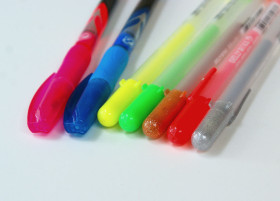 Gel pens have been around for about 30 years now, but only in recent years have the choices in colors exploded. Gel pens come in lots of colors, including neons, pastels, white, glow-in-the-dark, metallics, and glitters.
Gel pens have been around for about 30 years now, but only in recent years have the choices in colors exploded. Gel pens come in lots of colors, including neons, pastels, white, glow-in-the-dark, metallics, and glitters.
Gel pens use a ball point just like a ballpoint pen. The gel ink is nontoxic and eco-friendly. Even though the ink is permanent on paper, it easily washes off skin with soap and water. They write smoothly and the ink is often opaque (because they are pigment and not dye-based), which make them ideal for writing on colored paper and dark backgrounds. They have been used for years in scrapbooking, but only more recently have they entered the coloring world. If fact, when looking in a store for these pens, you’ll probably have to look in the scrapbooking section.
Some people love coloring with the gel pens because of the even coverage, vibrant colors, smoothness (you barely need touch the paper!) and specialty pens such as the metallics and glitters. They also do not bleed through the paper, as the pigment does not get absorbed into the paper.
One drawback to gel pens is that, since they are mostly water (and not solvent-based like a normal ballpoint pen), they apply fairly wet ink, which takes longer to dry (and thus, more prone to smudging). The pens don’t last as long either, as the ink gets applied fairly thickly, sometimes to the point of puddling. This also makes it hard to use in tiny areas. (Here’s a tip: have a toothpick or wooden skewer handy and use it to drag the ink into a narrow spot while the ink is still wet.) Being opaque, you need to be extra careful with your coloring, because you can easily color over an outline (the printed design). Unless you intentionally cover over all of the printed design, it will look sloppy. (A good investment for gel pen drawings is a fine-point black marker to fix mistakes.) You also cannot blend with gel pens. [Update: you can blend with gel pens if you use the right technique!]
While you can color an entire picture with gel pens, most people use them for accent colors or embellishments. They are excellent for adding your own touch to a coloring page, allowing you to add a pattern (like polka dots, stripes, swirls) on top of a colored area. I highly recommend getting at least a few of these to try for fun!
Quick Pick Recommendations for Gel Pens:
- Sakura 64-Piece Gelly Roll Artist’s Gift Set (the ultimate set! other smaller sets available)
- Sakura 3-Piece Gelly Roll Medium Point Gel Ink Pen Set, White (to add highlights, fix boo boos)
- Sakura 2-Piece Gelly Roll Stardust Pen Set, Clear (must-have to add shimmer over any other color!)
- Top Quality Gel Pens, 60-Pack (off-brand, but great starter kit to try for cheap)
- LolliZ Gel Pen 96 Pen Set (great reviews and great value)
Other Media
As as beginner, you will probably want to hold off on these for now, but since you may have seen them and been wondering about them, I’ll include them here.
Watercolor Pencils
Watercolor pencils are a fun, but tricky, versatile medium. You can use them as a normal colored pencil. But then you can apply water with a brush to float the color on the page, turning it into a watercolor painting. You can also wet the pencil first and apply it wet, or even touch a wet brush to the tip and paint as with normal watercolor paints.
This is one medium that you’ll want to experiment with before using on a favorite coloring page you want to keep. It takes a while to get used to the correct way to apply the color, wet or dry, and how to turn it into a color wash.
You also need to consider the paper surface. If you add water, normal paper will wrinkle. You need good quality, heavy paper or watercolor paper.
There is another unique product from Faber-Castell called Gelatos. They are kind of a cross between a watercolor pencil and an oil pastel. They are water-based, but are a creamy pigment stick like a lipstick. You can apply wet or dry and can blend with fingers or water. They get great reviews. I haven’t tried them yet, but they sound like fun!
Quick Pick Recommendations for Watercolor Pencils:
- Faber-Castell 24-Count Grip Watercolor EcoPencil Set (beginner set)
- Faber-Castell Aquarell Watercolor Pencils 36-Count (nice-quality)
- Derwent Inktense Pencils, 24-Count (artist-grade; not truly a watercolor pencil, but similar properties and more versatile! bigger sizes available)
- Faber-Castell Mix-and-Match GelatosTM Colors Gift Set, 28 Colors
Pastels
There are actually a few kinds of pastels:
Oil pastels are like soft crayons. They are creamy and apply thick, but rough, color. They blend easily with your finger, a Q-tip, or a tissue. Like crayons (even worse than crayons) they don’t have a fine tips and can’t be used for small details. But they can work nicely on large flowers or leaves, or for backgrounds. They are also nice for blending colors together.
Dry, soft pastels are more like a soft chalk. They can be blended nicely, and have bright colors, but can create a lot of dust. Also, the color never becomes permanent. You need to protect a drawing by either framing under glass or spraying a fixative. Hairspray may also be used (although I wouldn’t use it for an archival piece).
Dry, hard pastels are more like a denser, smoother blackboard chalk. They are hard, and like a chalk, can be smudged or blended easily. Also, like a chalk, they can create a lot of dust. The colors are typically more muted, so they make for nice, soft backgrounds. Also, because of their hardness, they can whittled to a point for fine details. As with soft pastels, they need to be protected when the work is complete.
There are also pastel pencils, that are pencils with a pastel lead. These can be used for adding fine details.
Paint
There are many kinds of paint and painting techniques and I can’t go into all of that here, but just a few notes about some types of paint:
Watercolors: Most people have used watercolor paints as a child. Parents like them because cleanup is easy. For coloring, it can be hard to control the paint and the depth of color you desire. You also need to make sure you are using it on very heavy paper or, better yet, watercolor paper. I would recommend taking a beginner’s course for anyone wanting to try watercolor painting.
Poster paints: These are also a favorite for kids. They are more vibrant and opaque than watercolors, but are still non-toxic and clean up with water. They are not usually used by adults, other than maybe when creating a poster, because of the limited number of colors. And because cheap pigments are used, it is difficult, if not impossible, to mix colors to make other variations. For example, you’d think that red and blue would make purple, but not with most poster paints!
Acrylic paints: There are two classes of acrylic paint—craft and artist. You can find the little bottles of acrylic craft paints pretty easily and they are fairly cheap and come in a wide array of colors. They wash up with soap and water, but are permanent when dry. The craft paints don’t have the same quality of pigments, however, so professional artists stick to the professional grade paints. But my daughter and I create paintings with the craft paints all the time and we enjoy using them.
Oil paints: Artists like oil paints for their vibrant colors, textures that can be achieved, blend-ability, and the slow-drying quality that allows them time to work. However, cleanup for oils is a PAIN. You have to use solvents on the brushes and your skin (just as with oil-based house paint).
Paint pens: People usually use paint pens for drawing a permanent design on a non-porous surface, such as a plate or mug. These are the pens you have to shake up first, then press down the tip to get the paint flowing. They come in limited colors. They aren’t often used for coloring pages, but the opaque quality lends them to similar uses as gel pens, especially for white or metallic paint pens. Unlike gel pens, they are solvent-based and do not wash off skin easily.


Thank you for all this great info!
Thank you! This article is very useful!
I really love crayola colour pencils and for markers i love berol or normal cheap ones i find can actually colour a lot smoother than my berol ones. As for watercolor the pentel watercolour brush pen is amazing, as you can fill the pen barrel with water and just dab that into watercolor paints and off you go!! Gel pens from the works.uk are fab too!!
Loved this post really handy! If you could check my blog, not much art/coloring related yet but will be putting up some pen reviews etc very soon xo
Thanks, Maria, for your feedback! I have a couple of old Berols in my stash, but I have no idea where they came from (some of my art supplies were inherited and I pick up stuff at yard sales too). But I can’t seem to find any Berols around here in stores (maybe they are only in the UK). I agree with you on the Crayolas. Lots of people keep pushing the real expensive ones, but frankly, I think I do just fine with the Crayolas! (The only thing they lack is the extensive color selection, so if I need a different color, I splurge on a single Prismacolor.) Other cheap brands, though, should be avoided at all costs!
Isn’t the water brush the best invention?! I’ve actually used it for sewing too – when sewing doll clothes and I have those tiny seams to press, I don’t want to drag out the iron, so just dampening the seam with the brush and finger pressing does the trick!
I checked out your web site. I love the unicorn! Looks like you are just getting started. Good luck! And let me know if you do some reviews – especially of things we can’t get in the states.
I loved your article. I have been coloring for years. IO am sio glad it is catching on. I am starting a coloring club in Altamonte Springs FL.
Thank you, Thelma. I’m so glad it’s catching on too! I rediscovered coloring a few years ago. And I started drawing pictures for my daughter and I to color. Glad we can now share with so many others!
Love this article! I’m so looking forward to part 2!!
FANTASTIC overview! Personally I’ve only tried one kind of Gel Pen, but you have me motivated to try the Sakuras…
Thank you! Since I wrote this I’ve also tried Inc Fashion Gel Pens (from Walmart) and have been really happy with them. I love the glitter ones, and the price was right! And they don’t seem to puddle as much as the Sakuras. One of these days I’ll update this article (and write Part 2)!
love your breakdown of the various mediums available for us to color with.I have several different mediums and have my favorites of course. I did find a very reasonable set of both water color pencils and they also make colored pencils that new people might like to start with. Fantasia Premium Artist Colored Pencils and Water colored pencils 36 count in each tin. Found at AC Moore.. and on Amazon.. little more than $20.00.per tin.. Not sure if you have used these.. ?? I also have used the Sakura Gelly Roll pens as a water color.. blending with a water brush..
Suzy, thanks! I haven’t tried those, but I’ll add those to my wish list! Since I wrote this article, I have played with the gel pens more and discovered ways of blending and it also makes sense that they could be used as a watercolor since they are water-based. Definitely will be trying that technique…
Pingback:Trendy Paper Crafts: Adult Coloring Books + Giveaway
Thanks for the great info.Looking forward to the next one.
Thanks for the great info! And all your hard work putting all of this together. Was wondering, is there a link to Part 2 ? I couldn’t find it.
Thank you!
I’m embarrassed to say that I never did a part 2… at least not yet! I have been trying out a lot more products since part 1, so I probably have enough material for an update!